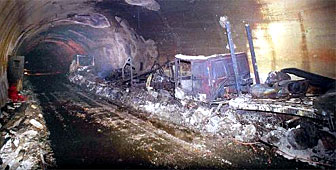Road tunnels need safety measures, group says

One of Switzerland's main environmental organisations has called for increased safety in the country's road tunnels, and recommended that lorries have built-in fire extinguishers to reduce the risk of a major disaster in the tunnels.
According to the Transport and Environment Association, two disasters have heightened awareness about safety – the Mont Blanc catastrophe in 1999 in which 39 people were killed, and another fire in Austria’s Tauern tunnel the same year, which claimed the lives of 12 others.
In both cases, trucks were involved in the accidents that sparked the infernos. Heavy vehicle fires in tunnels represent a particular risk, the organisation says.
In the Gotthard road tunnel, one of Switzerland’s main north-south thoroughfares, lorries are involved in fires six times more often than cars.
In the years to come, the risk of fire is likely to increase as the volume of traffic rises, according to the association. The number of trucks travelling through the Gotthard has doubled over the last decade, while car traffic has increased less than 10 per cent.
A proposal by the Federal Roads Office to carry handheld extinguishers in trucks doesn’t go far enough, according to the association. Automatic fire extinguishers, built into the lorries, would reduce the risk of motor fires spreading.
“Rescue” showed flaws
The recommendation comes just one day after emergency services for the first time cooperated in a simulated rescue operation in the Gotthard rail tunnel. The operation, codenamed “Granite”, brought together some 200 police, firemen and rescue workers in the early hours of Monday morning.
Organisers said the aim of the drill was to discover how long it would take to evacuate a large number of wounded people following a train derailment inside the Gotthard, which is the main rail axis linking northern and southern Europe.
A rescue train sent to reach those “trapped” inside the tunnel took more time than organisers had expected.
Officials also admitted the narrow entrances at either end of the tunnel had hindered the rescue efforts, while members of the evacuation team criticised the lack of an emergency escape route inside the tunnel.
The simulated accident was staged at 1:25am on Monday with the derailment of a military convoy four kilometres from the tunnel entrance. This was followed by a short circuit of the electricity supply.
The authorities are now investigating a number of safety measures aimed at increasing safety in the tunnel and facilitating the work of rescuers in the event of a real accident.
Emergency lighting is being installed, while a fire-fighting train is to be put on permanent standby in Airolo, at the southern end of the tunnel.
swissinfo with agencies

In compliance with the JTI standards
More: SWI swissinfo.ch certified by the Journalism Trust Initiative
You can find an overview of ongoing debates with our journalists here . Please join us!
If you want to start a conversation about a topic raised in this article or want to report factual errors, email us at english@swissinfo.ch.